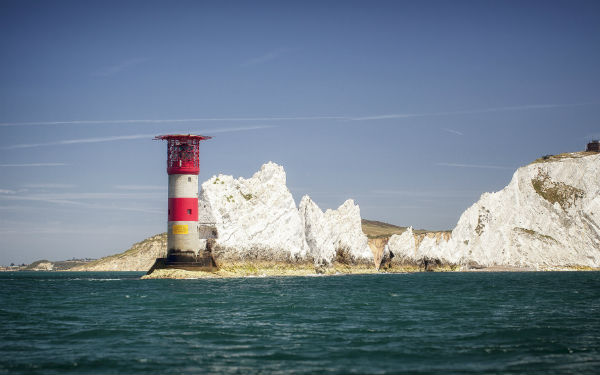
“I came away smiling,” is perhaps not the first response you’d associate with social workers encountering Ofsted inspectors.
But those are the words of Lisa Barton, one of the children in care team at Isle of Wight council, who adds that she “couldn’t believe how good” her experience of an Ofsted inspection in late November 2018 was.
“I came away thinking, ‘I’m confident in my cases and I know what I am talking about,'” Barton says.
“Where anything was [queried by inspectors], there was already a plan about why something might not have been done, or what’s going forward for this young person.”
Soon after the new year it emerged that Ofsted’s view of the visit was similarly upbeat.
The island council, which had received a brutal ‘inadequate’ judgment in 2013 that led to the government directing that its children’s services be managed by neighbouring Hampshire council, was now deemed ‘good’ in all areas.
The inspectors’ report marking the turnaround – which began with a 2014 ‘requires improvement’ rating – made repeated reference to how the partnership, the first of its kind, had improved stability and brought “resilience” to the Isle of Wight.
A few weeks on, Community Care took the hovercraft over the Solent to hear what difference the model has been making to the social work sharp end – and why it looks set to continue.
‘Frameworks don’t give you the basics’
Ofsted’s January 2013 judgment, and serious case reviews published around the same time, paint an alarming picture of the state of safeguarding on the Isle of Wight in the early years of this decade.
For several years before, inspectors warned services were underachieving. In response, local politicians approved a series of restructures, culminating in an optimistic but botched implementation of the Reclaiming Social Work model pioneered in Hackney.
“Children’s services appear to have introduced the model without the concomitant checking of social work competence, change in culture and necessary consultation with partner agencies,” concluded one review into serious injuries sustained by a baby on the island.
Behind the rushed system change, the review found, lay “deep seated and endemic” problems with social work practice. Like the Ofsted report, it flagged up serious issues with thresholds, quality assurance and management oversight.
“Directors would come in with ambitious plans, start making changes, then leave – it was a constant state of change,” recalls Simon Dear, now the service manager responsible for strategic development and commissioning on the Isle of Wight.
Assumptions were made by elected members about the underlying solidity of social work practice that were essentially left untested because of the surrounding flux, Dear adds. The continual change, he says, was a distraction for all concerned.
“If you haven’t supported staff to be the best they can be, it doesn’t matter what framework you put in – it is not a panacea for getting the basics right,” adds Kathy Marriott, the council’s head of strategy and operations.

Kathy Marriott, Isle of Wight council’s children’s services head of strategy and operations
‘A hard thing to have imposed’
Hampshire council’s decision to become involved in the situation in summer 2013 came only after lengthy negotiations with the Department for Education (DfE). The DfE and Isle of Wight approached the mainland authority because it had been rated good over a long period, and because of its geographical proximity.
“It was the first time this had been done anywhere, and what was clear was that Hampshire’s managers needed to have the authority and mandate to do what they needed,” says Ray Jones, emeritus professor of social work at Kingston University.
Hampshire had to weigh up whether the arrangement might overstretch its own highly-rated services, adds Jones, who chaired the government-mandated children’s services improvement board on the Isle of Wight for two years after the 2013 Ofsted inspection.
A tale of two councils
Ofsted reports carried out within a few months of each other in 2014 at Hampshire and the Isle of Wight demonstrate the demographic differences between the two authorities – and how the island has slotted in almost as an auxiliary district to add to Hampshire’s existing eight. At 280,150, Hampshire’s population of children and young people was just over 10 times that of its island neighbour, which had 26,168.
The larger council was also more affluent overall, with 12% of its children living in poverty in 2014 against the Isle of Wight’s 20%. That picture is borne out in the number of children claiming free school meals, with the Isle of Wight’s figures close to then-national averages of 18% for primary schools and 15% for secondary, while Hampshire’s numbers were much lower at 11% and 9% respectively.
In 2014, Hampshire’s proportion of children from minority ethnic backgrounds, 8%, was almost double the island’s 5% – though still far below the then-national average of 22%.
“We felt a moral responsibility to support our colleagues – and children on the island,” says Stuart Ashley, assistant director for children and families at Hampshire, adding that after careful consideration the council concluded its size would enable it to take on the task. Echoing Jones, he says that the statutory direction compelling the Isle of Wight council to comply with Hampshire was crucial in sealing the deal.

Stuart Ashley, assistant director for children and families at Hampshire council
“Without that, in the early days [the island’s] elected members would have withdrawn from the agreement if not obliged to continue,” Ashley adds.
“Politically, it was a hard thing to have imposed on them.”
However, the need for authority had to be balanced with a sensitive, trust-focused approach to what – as several Isle of Wight staff point out – could easily have been seen as a takeover.
Following the Isle of Wight’s inspection, Jones recalls, agency managers experienced in troubleshooting were brought in to steady the ship, and had stuck around until the partnership began.
But there had been the usual exodus of frontline staff that follows a negative inspection. By the time Hampshire arrived six months later, half of the workforce were agency staff.
“For the first three months, we didn’t do anything,” says Steph How, now Hampshire children’s services’ head of strategy and operations, who was seconded from being a team manager at Hampshire into a service manager role on the island for the partnership’s first year.
“We assumed responsibility but didn’t take decisive action – we wanted to listen to staff, hear what was working and what wasn’t,” she adds.
‘No policies and procedures’
Frontline staff who were on the Isle of Wight in 2013 deny it was ever a terrible place in which to come to work, citing supportive workmates and the close-knit nature of a small council. But most admit that, with hindsight, systems had gone badly wrong.
“I remember, on my first day, I asked about policies and procedures and was told there weren’t any,” says Sara Carvalho, who arrived on the island from Wales for her first agency role in the wake of the ‘inadequate’ judgment.
“It seemed there was [no structure] and different teams were doing different things,” adds Carvalho. But, she goes on, she stuck around because of “good people around me” and a sense of positive change, and is now a team manager.
Like other staff, she says there was initial apprehension at Hampshire taking charge, but also an immediate sense of relief and safety as order began to be imposed.
Tried-and-tested systems
That process came in several parts. The first, and fastest of these, was the wholesale importing of tried-and-tested systems from Hampshire.
The two authorities began sharing Hampshire’s well-regarded multi-agency safeguarding hub (MASH), helping to bring consistency to thresholds. Meanwhile the Reclaiming setup was quickly dismantled and replaced with more traditional referral and assessment, child in need/child protection and children in care teams, with new processes and quality assurance to go alongside.
“We prioritised what was needed to immediately help us make children safe – and at the same time take staff with us,” says How. “So lifting over our framework for legal planning meetings, permanence policy, single assessment, all those I took with me and we implemented fairly quickly, alongside a training programme.”
‘Command and control’
With those building blocks in place, implementing more lasting stability depended on a settled workforce. This meant showing belief in good staff already at the council – who might not have had an opportunity to advance so soon during more settled times.
“We really invested in workforce development, talent-spotted and put aspiring team managers on good programmes,” says Marriott. “We had senior managers over from Hampshire on secondment for the first year – it was a bit command and control, really robust oversight because our new managers and assistants were not yet the finished article.”
More senior staff – including Marriott, now the top boss on the island, who sits underneath Ashley in the combined children’s services structure – also had opportunities to do secondments, and informal shadowing, on the mainland. Meanwhile Hampshire leaders remained visible and accessible to staff.
The agency staff quota was gradually whittled down through a focus on home-grown newly qualified social workers (NQSWs), coupled with market supplements of up to £4,000 for experienced workers, and other benefits including a nine-day fortnight. It now stands at 8%; several of the social workers we interview are islanders who joined after qualifying and say they are in for the long haul.
The journey back to ‘good’
- 2012: Ofsted inspectors visit the Isle of Wight late in the year and grade its children’s services ‘inadequate’ in January 2013. An interim management team and many other agency staff are brought in with a brief of making the front door safe, but do not enact other major changes.
- 2013: Department for Education issues a statutory direction in June ordering the Isle of Wight to enter a five-year strategic partnership with Hampshire.
- 2014: The island achieves a ‘requires improvement’ grade from Ofsted in the late autumn after a year spent focusing on caseload management, workforce development and rebuilding partnership working and the local safeguarding children board.
- 2015: Peer inspection from Hampshire deems services on the Isle of Wight ‘good’.
- 2017: Hampshire named one of first eight high-performing ‘partners in practice’ councils by the DfE.
- 2018: The Isle of Wight adopts Hampshire’s CAST system, which sees social workers manage cases from referral through to care proceedings.
- 2019: In January, Ofsted awards the island a ‘good’ rating across all aspects of its children’s social care.
While restocking a supply of decent practitioners is a challenge ‘inadequate’ councils inevitably face, another difficult part of turning things around lay in rebuilding wider safeguarding networks on the island. Jones recalls that trust in the council had fallen so far that then-education secretary Michael Gove had to intervene directly to get one independent school to re-engage with it.
“In the first 18 months as we drove towards ‘requires improvement’, we accepted our partners’ criticism,” says Ashley, noting that schools and health services were also struggling. “But as we improved, we were able to say to partners, ‘You also need to and come on this journey with us,’ and that has helped speed up progress.”
Cementing that progress also meant rejuvenating councillor scrutiny, which had failed to prevent things from spiralling in the first place.
“Many politicians were quite shocked the island was ‘inadequate’ because there weren’t proper governance arrangements for scrutiny,” Ashley goes on. “One of the first things we did, besides briefing elected members, was improve those arrangements so they understood how children’s social care was performing, what it needed to do to get to ‘requires improvement’ and on to ‘good’ – and were involved in that process.”
‘There is a richness’
Councillors’ regard for their authority’s partnership with Hampshire was given a clear demonstration before that process was even concluded, when in late 2017 they voted to renew it for a further five years.
The intervening 14 months have included some change of the kind seen in the early phase of the partnership, with the shift to Hampshire’s children’s assessment and safeguarding team (CAST) model in 2018 being well received. Under the system, social workers handle cases all the way from assessment to care proceedings, with a rotating duty team, meaning fewer transitions for families.
But practitioners on the island describe the relationship between the councils as very different – and more equal – than when its neighbour arrived in 2013.
If it’s not broke
Even at the time of the Isle of Wight’s 2013 ‘inadequate’ judgment, when a meltdown over thresholds meant it was carrying cases that should have been at statutory level, the council’s early help service was seen as solid – something that was acknowledged in the report inspectors produced when they returned in 2014.
While other areas of children’s services have seen considerable change to align them more with Hampshire’s way of doing things, the early help service has been largely enabled to continue playing to its strengths, says manager Carol Attrill. Like some of her colleagues, she explains that one of the benefits of the island’s small scale is that partners from other agencies are usually within easy reach, enabling close coordination.
“Here, we just have two coordinators [based within the children’s social care department],” she says. “All the work is done out in the community – it’s embedded in the work of schools, health visitors, school nurses, voluntary organisations and so on.There’s never been pressure to change.”
Nonetheless, Attrill says, the partnership with Hampshire has enabled the two coordinators to develop in directions they would otherwise have been unlikely to. In Attrill’s case this has meant being able to take a lead on missing, exploited and trafficked children, a role that involves considerable work with colleagues on the mainland.
Attrill says the opportunity was due to Hampshire’s restructure giving the early help service a more direct connection into senior managers. “Afterwards, we answered to a service [rather than team] manager, so we gained more of a voice both operationally and strategically,” she says. “We were more able to say, ‘How about this?’ in terms of family centres, children’s centres and how we work with other professionals – that made a big difference.”
“The partnership opens doors for training [because costs can be shared], also joint policy writing and ensuring consistency, sharing ideas and regularly meeting,” says Karen Cheeseman, manager of the Isle of Wight’s leaving care team. “Having lots of people with different experience to draw on, there is a richness.”
Peer inspection
Several social workers mention having enjoyed now being part of Hampshire’s peer inspection regime, via which different teams visit one another once or twice a year pretending to be Ofsted.
“We get to visit Hampshire and go, ‘they do that really well but we do that bit better – what can we learn from each other?'” says Lisa Graham, who manages one of the CAST teams.
“[These days] it’s not like Hampshire has an idea and we have to implement it – there is a discussion, and staff are quite receptive,” adds Carvalho. “When we joined it was, this is how we do things; now there’s an element of choice.”
Whether the model, in the wake of the Isle of Wight’s success, becomes more widely replicated remains to be seen. Along the South Coast at Torbay, Plymouth council took control in 2018 but things are still at an early stage.
But Marriott, Ashley and How all agree it can be a template that offers a compelling alternative to failing children’s services being taken out of council control – providing the geography, featuring compatible neighbours, is right.
“For our staff, this has provided stability within a model that works, recognises differences but provides quality support and consistency,” says Marriott. “With the resources we have, it’s about doing the best for families in an integrated way.”



 A trauma-informed approach to social work: practice tips
A trauma-informed approach to social work: practice tips  Problem gambling: how to recognise the warning signs
Problem gambling: how to recognise the warning signs 




 Find out how to develop your emotional resilience with our free downloadable guide
Find out how to develop your emotional resilience with our free downloadable guide  Develop your social work career with Community Care’s Careers and Training Guide
Develop your social work career with Community Care’s Careers and Training Guide  ‘Dear Sajid Javid: please end the inappropriate detention of autistic people and those with learning disabilities’
‘Dear Sajid Javid: please end the inappropriate detention of autistic people and those with learning disabilities’ Ofsted calls for power to scrutinise children’s home groups
Ofsted calls for power to scrutinise children’s home groups Seven in eight commissioners paying below ‘minimum rate for home care’
Seven in eight commissioners paying below ‘minimum rate for home care’
 Facebook
Facebook X
X LinkedIn
LinkedIn Instagram
Instagram
Always helpful to have good neighbors. But clearly this was no quick fix -it seems to have taken six years. Although this article focuses on how some practitioners felt the social work was never that bad but the structure and policies were not in place to support them adequately which seems to imply they were let down by senior management hence the need for managers from a neighbouring authority to take over. However the article also refer to a rapid turn over of directors/senior managers contributing to the difficulties experience by social workers. I would wonder what part was played by members and why they could not hold on to directors/senior managers. Was there also a lack of support ( political and resources) for senior managers?